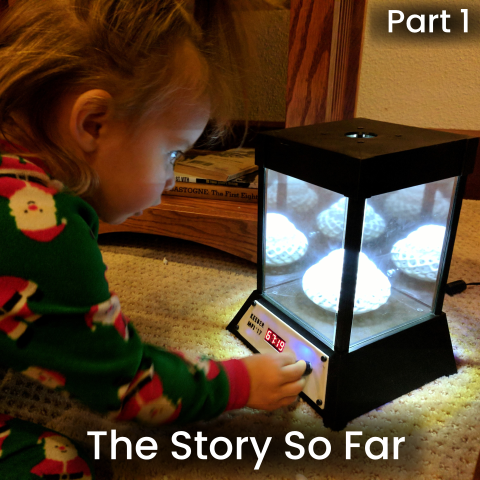
The Story So Far: Part 1/3
March 25, 2021
Brandon Keeber
It was September of 2017, and I was mindlessly browsing Facebook after another soul-crushing day at my entry-level job as a manufacturing engineer. I came across a video showcasing a new discovery; that a novel optical illusion could be produced by spinning flowers up on a motor and subjecting them to a strobe light. I couldn't find anyone selling any products utilizing this effect, so I decided to try my hand at making my own. I bought a 3D printer, taught myself the basics of microelectronics, and spent the next three months trying to build something that was beautiful and functional enough to give away.
A design was settled on which resembled an obelisk, and five units were made for friends and family just in time for Christmas.
Recipients seemed to enjoy their gifts. From left to right:
My 1 year old niece, Victoria ~ My [redacted] year old father, David ~ My 56 year old (in dog years) pup Cookie, who had some difficulty controlling the knob.
 My 1-year-old niece Victoria showing a strong fascination with her new Novatrope.
My 1-year-old niece Victoria showing a strong fascination with her new Novatrope.
|
 My dad contemplating the magnitude of his son's awesomeness as he plays with his Novatrope. My dad contemplating the magnitude of his son's awesomeness as he plays with his Novatrope. |
 My dog Cookie, contemplating the existential nature of existence as she gazes into a Novatrope. My dog Cookie, contemplating the existential nature of existence as she gazes into a Novatrope. |
The feedback received was overwhelmingly positive and we even fielded a few requests to purchase units. We started thinking about how to manufacture them, but there were a number of problems, the biggest of which was the build time and cost of each unit. It took 55 hours of 3D printing for one, 3 to 4 hours of assembly, and about $150 per unit. Not super scalable. The main culprits were the base and lid. To reduce build time, we built a vacuum former and started creating pieces in a fraction of the time. A new model was designed which incorporated this, dubbed "The Pagoda".
With all these changes made, it lowered the build time substantially. Unfortunately it didn't lower the unit cost to build, which resulted in a purchase price that most people couldn't afford.
It wasn't all for naught however, as it taught us a tremendous amount about how to design for manufacturing. The biggest lesson learned? REDUCE COMPLEXITY. The Pagoda model had over 150 parts and lots of moving parts, like a lift hinge door with 30 parts alone.
Beautiful? Yes. Over-engineered? Also yes. All these satisfying but impractical features had to go away. To describe how we came up with a more elegant design, I need to start with the story of the MegaTrope, which I'll continue in the next post to keep the size of each blog post within reason.




 My 1-year-old niece Victoria showing a strong fascination with her new Novatrope.
My 1-year-old niece Victoria showing a strong fascination with her new Novatrope.
 My dad contemplating the magnitude of his son's awesomeness as he plays with his Novatrope.
My dad contemplating the magnitude of his son's awesomeness as he plays with his Novatrope. My dog Cookie, contemplating the existential nature of existence as she gazes into a Novatrope.
My dog Cookie, contemplating the existential nature of existence as she gazes into a Novatrope.

